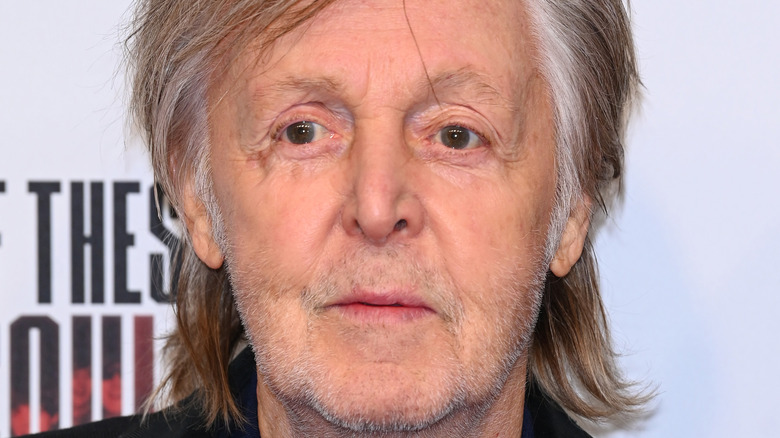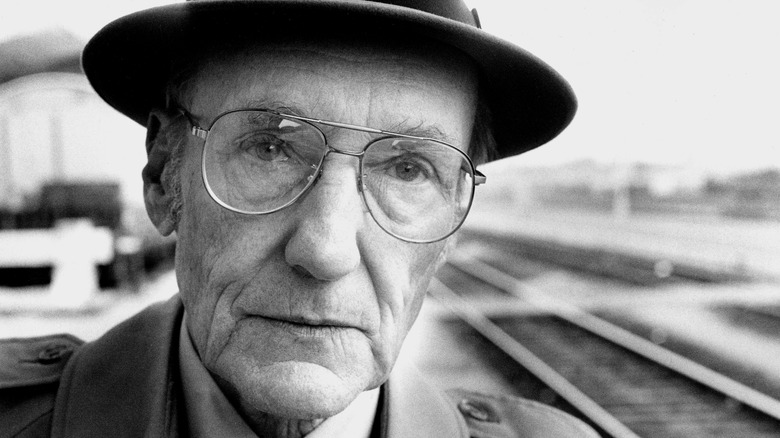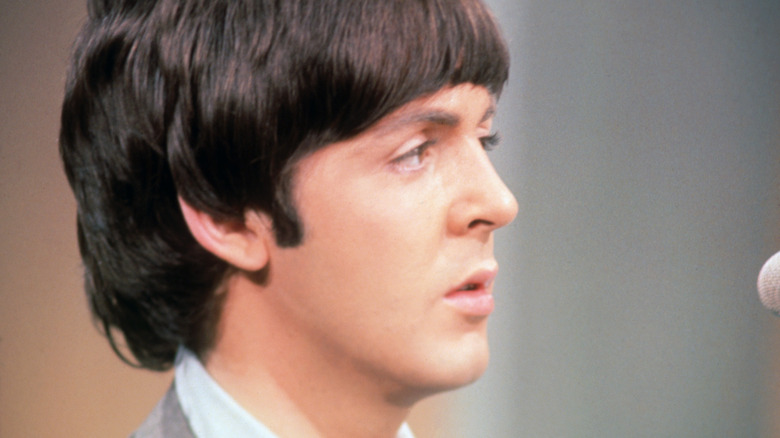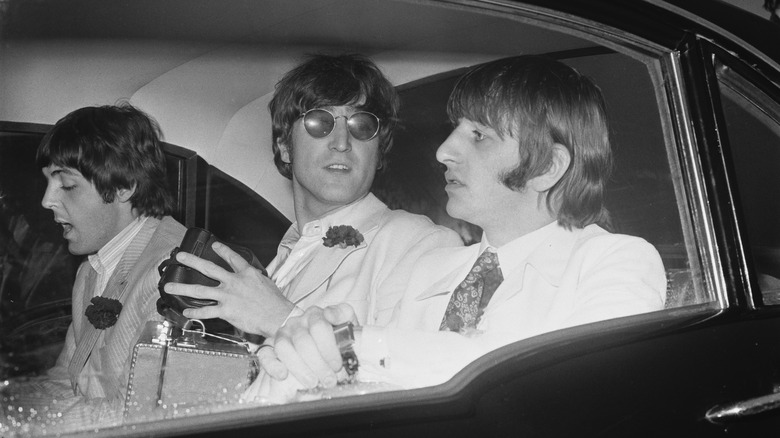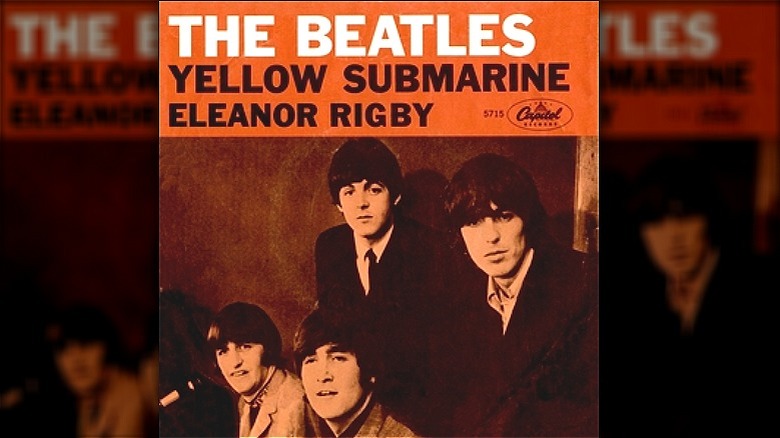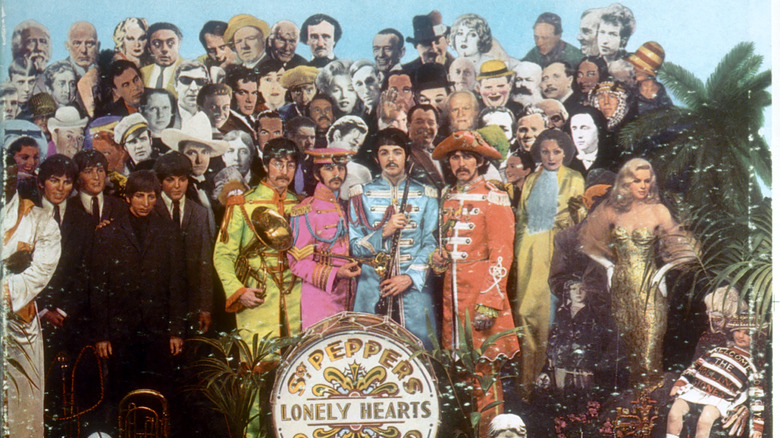Paul McCartney And William S. Burroughs' Relationship Explained
In the spring of 1966, Paul McCartney and William S. Burroughs sat together chatting at a luxury apartment in London that McCartney had turned into an avant-garde recording studio. The influential beat writer, 52, and the Beatle, nearly 30 years younger, spent the evening discussing the future of rock music at the dawning of the electronic age and the possibilities of using recording equipment for looping, overlaying, and other techniques, according to "With William Burroughs: A Report from the Bunker."
McCartney had met the American writer of such classic novels as "Naked Lunch" through a mutual friend. "He and I had met through the author Barry Miles and the Indica Bookshop," McCartney recounted in a 2021 The New Yorker article. That year, the two men shared the recording studio with very different results, and the older artist's work ended up influencing The Beatle's music, which helped change the course of rock.
Who was William S. Burroughs?
William S. Burroughs was the Harvard-educated grandson of a famous inventor of a type of adding machine and was born in St. Louis, Missouri, on February 5, 1914, per Biography. In the 1940s, he moved to New York City, held down a series of odd jobs — including as a pest exterminator — and became friends with other young writers, including Allen Ginsburgh and Jack Kerouac (via The American Reader). The three were at the vanguard of what would come to be known as the Beat Generation, a style of writing that explored spirituality through Eastern practices and mind-altering substances and rejected materialism and traditional narrative, among other aspects.
Their literary movement, which became a social movement, helped lay the foundation for the hippies of the 1960s. For Burroughs, the 1950s were a tough time. He'd been a long-time heroin user and, in 1951, accidentally shot and killed his wife during a drunken game of target practice in Mexico City, per Biography. He finally "kicked his heroin habit" in 1957, according to Harvard Magazine. The 1960s would be a highly creative and influential period for the beat writer.
If you or anyone you know needs help with addiction issues, help is available. Visit the Substance Abuse and Mental Health Services Administration website or contact SAMHSA's National Helpline at 1-800-662-HELP (4357).
A writing technique becomes a recording technique
William S. Burroughs spent the latter part of the 1950s living abroad, spending time in South America, North Africa, and Paris, before moving to London. By the 1960s, he was experiencing a hugely creative period that wasn't very marketable. Now openly gay, he was dating a mathematician and sound engineer named Ian Sommerville, who helped Burroughs and his friend and collaborator, the painter Brion Gysin, in creating sound collages, according to "Paul McCartney: Many Years From Now." In 1959, Gysin had invented "cut-ups," a technique that involved literally cutting up written texts and rearranging them to create new ones, per Brion Gysin.
Burroughs began incorporating the technique in his novels, and he and Gysin also experimented with other formats, including audio recordings and film. In 1966, Paul McCartney hired Sommerville to run a new recording studio he was setting up at his bandmate Ringo Starr's unused London apartment, according to "Call Me Burroughs: A Life."
McCartney's avante-garde recording studio
Paul McCartney and Barry Miles decided to create a small recording studio for poets and avant-garde musicians to record with the idea that these disparate artists could exchange ideas. "Poets in Liverpool would be able to hear the latest developments in beat music from London, and vice versa; rock musicians could send their work in progress to their fellow musicians in the USA, and so on," Miles wrote in "Paul McCartney: Many Years From Now."
They put Ian Sommerville in charge of turning the basement of Ringo Starr's posh residence at 34 Montagu Square into a recording studio with McCartney footing the bill, per Miles' book. William S. Burroughs felt that as The Beatles began to experiment more, the corporate interests involved with the band were against the move. "It was kind of uneasy there," Burroughs recalled in "With William Burroughs: A Report from the Bunker." "There were people like bodyguards and managers who didn't like this at all and they were always threatening to come around and take away the equipment." Even so, Burroughs managed to record many experimental works at the studio.
The birth of Eleanor Rigby
Initially, Paul McCartney thought he would use the studio to record more experimental work, along the line of William S. Burroughs' and Brion Gysin's cut-ups, but he mostly went to the space to work on a new tune, "Eleanor Rigby." "I thought, let Burroughs do the cut-ups, and I'll just go in and demo things," he recalled in "Paul McCartney: Many Years From Now." McCartney did make a recording (apparently now lost) with Burroughs and other friends that included cello and guitar, per "The Unreleased Beatles: Music & Film."
While Burroughs worked on his experimental soundscapes, McCartney worked out the kinks in "Eleanor Rigby." "I saw the song taking shape," Burroughs said in "With William Burroughs: A Report from the Bunker." "I could see that he knew what he was doing. He was very pleasant and very prepossessing." McCartney recalled his conversation with the writer after Burroughs had heard the finished song. "When he got to hear the final version of 'Eleanor Rigby,' he said he was impressed by how much narrative I'd got into three verses," McCartney wrote in The New Yorker. "And it did feel like a breakthrough for me lyrically — more of a serious song." More importantly, the exchange of ideas between McCartney and Burroughs helped pave the way for the sonic experimentation of "Sgt. Pepper's Lonely Hearts Club Band."
Burroughs' influence on Sgt. Pepper's and other music
William S. Burroughs' sound experiments would lead to The Beatles' use of found sound and tape cut-ups in "Sgt. Pepper's Lonely Hearts Club Band" the following year, according to "William S. Burroughs and the Cult of Rock 'n' Roll." The groundbreaking album had an enormous impact on popular music and inspired other artists of the period, including Pink Floyd and The Rolling Stones, per Far Out Magazine. In a nod to Burroughs, The Beatles featured his image — along with other important writers, thinkers, and entertainers such as Edgar Allan Poe, Carl Jung, and Marilyn Monroe — on the seminal album cover.
Besides The Beatles, Burroughs' work had a major influence on many musicians, from Bob Dylan to Lou Reed to Patti Smith to David Bowie, according to Wisconsin Public Radio. Dubbed "the godfather of punk" by Patti Smith, Burroughs' work had an outsized influence on the genre, per the BBC. He even sent the Sex Pistols a letter of support when they were getting backlash for their song "God Save the Queen," according to Far Out Magazine. Burroughs died in Lawrence, Kansas, in 1997. At age 83, he was still making innovative art and influencing popular culture.
